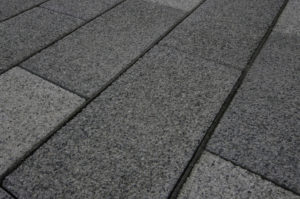The increasing urbanisation of the countryside and changes in rainfall patterns has led to much higher volumes of surface water entering sewerage systems and water courses.
This, in turn, has resulted in higher instances of flooding in city centres, greater expenditure on new sewerage systems and insurance companies increasing premiums on properties built in vulnerable areas. One of the many solutions currently being promoted to help alleviate these problems is permeable paving.
Permeable paving is a range of sustainable materials and techniques for permeable pavements with a base and Sub base that allows the movement of storm water through the surface. In addition to reducing runoff, this effectively traps suspended solids whilst filtering pollutants from the water.
Hardscape can offer a unique system of Drainjoint which can be used across all types of natural and man-made hard landscape paving materials together with specific conventional pavers in both concrete and clay. Also on offer are Kellen H2O and Kellen Green Paving solutions.
DRAINJOINT

Drainjoint permeable paving is easy to install and can be used with many different materials. Removing the need for pavers to carry nibs or extensions and avoiding the requirement for large, unsightly aggregate joints, the system preserves the beauty of the paving material.
Drainjoint allows for any material to be laid as a permeable paving system, be it natural stone, clay or concrete, and it can accommodate any paving size (not just those designed for a 6mm aggregate joint). The product is designed to be sustainable, cost-effective and easy to install.
No aggregate joints mean no continuous maintenance or rattling of blocks. No rattling reduces the potential for surface failure and eradicates the need for expensive rejointing.
Paving can be cleaned with a standard mechanical sweeper and, as Drainjoint is non-degradable and does not absorb water, there is no potential for freeze-thaw damage.
Click here to download the Drainjoint PDF.
Click here to download the Drainjoint Technical and Case Study PDF.
H2O PAVER
The Kellen H2O paving system is an innovative permeable block paver that provides an attractive, durable surface finish, while also acting as an effective drainage solution. Available in Breccia and Lavaro finishes and corresponding colours.
The continuing growth of urbanisation, combined with increasingly extreme weather events, means that flooding and water damage are now of great concern for many households. Sustainable Urban Drainage Systems, or SUDS, are recognised as an efficient approach to surface drainage in urban areas. H2O Pavers work in conjunction with SUDS, and other drainage systems, to gradually disperse water in a controlled process. Water passes through the joint between each paving unit and into the permeable sub-base beneath. Here it connects with the installed drainage system, where it is stored and slowly released.
The permeable properties of H2O Pavers prevent standing surface water from forming. This enhances urban design by eliminating the need for channels or gullies. The spacers are manufactured to allow for a wide variety of laying patterns, making the system suitable for both pedestrian and vehicular use. Infiltration rates are determined by the jointing material applied.
GREEN PAVING
SUSTAINABLE GRASS PAVING
The city of the future will need to take account of an increasing risk of flooding resulting from climate change. An increase in paving in urban areas is leading to the existence of so-called urban heat islands; places where sunlight is absorbed more rapidly as well as being preserved longer.
Whenever the lay-out of an urban environment is rearranged, climate adaptation necessitates several simultaneous solutions. It is a huge challenge to realise a spatial layout that is comfortable for its users in all prevailing circumstances, both in normal situations and under extreme weather conditions. Adequate solutions are then called for, e.g. greenery which has a cooling effect and urban spaces including water storage to cope with extreme precipitation.
Local authorities are increasingly having to face the challenge of climate-proofing both for existing and new projects. This means adjusting urban redevelopment to climate change so that residents can live and enjoy recreation safely and comfortably. One of those solutions is to have more greenery within pavements. Greenery enhances public spaces and makes it more attractive to users, retains less heat and has a cooling effect because of water evaporation. In addition, grass pavements ensures, by virtue of its open character, that rain water can be absorbed into the soil.
However, traditional paving remains necessary to ensure the convenience and accessibility of public spaces. Alternating pavement and greenery increases the quality of life in urban areas.